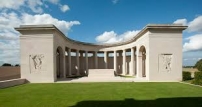| First Name: | Frederick George | Last Name: | SNAZLE | |
|---|---|---|---|---|
| Date of Death: | 20/11/1917 | Lived/Born In: | Kew | |
| Rank: | Lance Corporal | Unit: | Hampshire2 | |
| Memorial Site: | 1. Richmond-on-Thames Memorial 2. Cambrai Memorial, Louverval, France | |||
Current Information:Age-25 64, Windsor Road, Kew
The Battle of Cambrai This was a major British offensive on the Western Front that was launched on 20th November, 1917 and lasted through to the beginning of December. As the name suggests it was an attack towards the city of Cambrai and the important German railhead there, which it was hoped would be captured. The battle was notable for two things: the massed use of tanks for the first time and the success of the first day’s fighting when the formidable Hindenburg Line was breached and gains of five miles were made in places. In celebration the church bells throughout Britain were rung. However this success was short lived. The tanks were not reliable and the German defence stiffened as the fighting progressed and when they counter attacked in force on 30th November, the British came under so much pressure that they were forced to withdraw from many of the positions they had captured earlier on. Both sides suffered around 45,000 casualties during the course of the fighting. At 10.15am on 20th November, the opening day of the battle, 88 Brigade of 29th Division went forward with the 1st Essex battalion in front and 2nd Hampshire bringing up the rear. They advanced towards Masnières via the la Vacquerie valley following four tanks of A Battalion, three of which were knocked out by a German field battery on Welsh Ridge after which, 1st Essex captured the guns and took 70 prisoners. But this delayed them in their task which was to cross the canal at Masnières, clear the village and establish a bridgehead and they were overtaken on the right by 4th Worcestershire who managed to get two companies across the canal opposite the sugar factory, Further progress was impeded when the main bridge collapsed as a tank was trying to cross it. At 2.15pm 2nd Hampshire arrived at Masnières and began crossing the canal by a lock, 300 yards south-east of the bridge. They crossed in single file exposed to machine gun and rifle fire and established themselves next to 4th Worcestershire. That evening, 1st Essex made gallant but fruitless efforts to force the passage of the canal and clear Masnières, something that was achieved that night by the combined efforts of 4th Worcestershire and 2nd Hampshire. Frederick Snazle of 2nd Hampshire was among the many from 88 Brigade who did not survive the day. |
||||
| « Back to Search Results | ||||
| If you think any of the information shown here is incorrect, Click Here to submit your amends and comments | ||||




